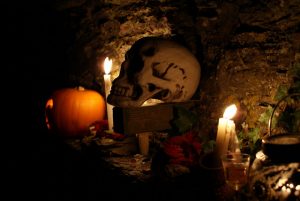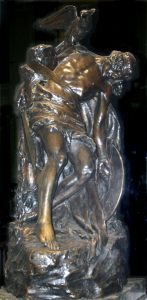
Redcap’s are a very small myth, but one with a lot of potential for interesting interpretations – all of them murderous and mischievous, whether that be 13th Age with their fourth-wall breaking “secret word” or Redcap Jack in the Dresden Files.
History
Redcaps are a murderous fairy, said to be found on the border of England and Scotland, mostly in castles. As for how old these monster are there is no hint really other than they reside in ruined castles especially those ones that have seen a tyrant, which in Britain there have been lots of since the time of the Romans.
Their stories don’t tell of them causing mischief like most fairy instead they chase and kill any trespassers on their land, either by hit people with boulders or with his sharp teeth or using there iron spiked boots, then they sock there hat in the victim’s blood which is how it come to be red. If there red should fade then so would the redcap – so they must kill to stay alive.
These story were often told to keep people out of ruined castles where rocks might fall on them, but also to stop people nosing around where they don’t belong, this maybe why Lord William de Soulis was said to have one as a familiar which resided in his castles to keep people out when in imprisoned in Dumbarton Castle which he died in but some story say that his redcap killed him.
Another theory is that the redcap may be a metaphor for redcoats i.e. the English, who would often make use of the old castles, throughout the wars with Scots – however this seems unlikely as there are references to redcaps that predate the standardisation of the English to the red-coat military uniform.
Physiology
- Usually bald or with thin gray hair
- Large beady red eyes
- Hooked noses
- Wide mouth full of sharp teeth
- All of these features sit upon the face of an old man
- Their body may be fat or skinny but is alway wrinkly, usually covered in earth coloured clothing or armour.
- Long boney arms and hands with sharp long nails
- Short boney legs
- Iron boots on their feet
These murderous old fairy may be faster and stronger than most humans – which allows them to hunt their prey in their ruined homes.
Ideas
The iron boots are odd since they’re fairies and iron is meant to hurt fairies – this might mean they’re in constant pain, or that they’re immune to iron1)or even both – resistance through constant exposure. It’s also possible they use these boots to stomp on other, less bloodthirsty, fairies.
They would make sense for assassins and serial killers in the modern day world.
If they die from the red fading on their cap, are there other ways to kill them, like destroying their cap?
Does it matter if the blood on the cap is from someone dead, or could they use portions from living people? If that is the case would a redcap be able to keep himself alive by doing blood letting of not just his victims but himself.
A great little fantasy idea is that a redcap is a gnome that been bitten by a vampire.
References
| 1. | ↑ | or even both – resistance through constant exposure |


